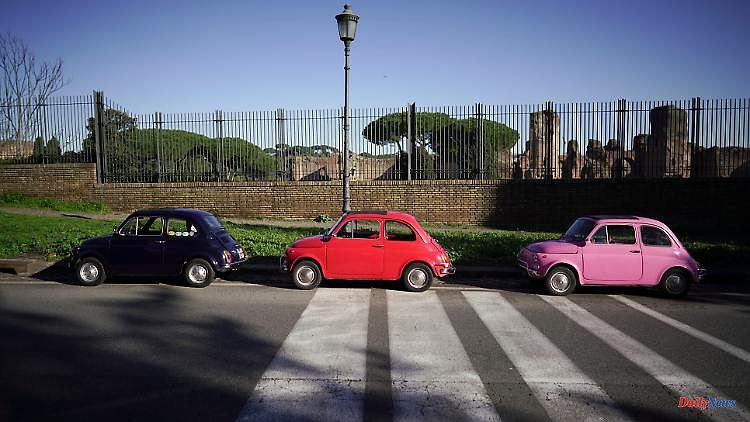Since the first models of the Fiat 500 rolled off the production line 65 years ago, the cult car has become an integral part of Italian roads. Over the years, the car company has produced different variants. Fiat makes a drastic decision for the future of the little Italian.
US actor Tom Cruise sped with him through the old town of Rome for filming, pop star Jennifer Lopez got behind the wheel in a commercial, and Pope Francis regularly climbs into the back of his car. The Fiat 500 may not pass as a luxury sled, but it has been a car for the people for decades - and not only in Italy. On July 4, 1957, the first models rolled off the assembly line in Turin, northern Italy, at that time under the name Fiat Nuova 500.
It was advertised as a "small, great car" at the time. A "loyal friend" - regardless of whether you go to the sea or to the mountains, it said in the TV spot. 65 years later, the "Cinquecento" (Five Hundred) is an integral part of Italian roads. Over the years, Fiat produced various variants of the 500, from the convertible to the sports version to the stretched "giardineria" (garden shop) - a kind of station wagon. Since then, Fiat has sold more than 7.1 million 500 models, as company spokesman Marco Freschi explains. The company is now part of the Stellantis car group, which emerged in January 2021 from the merger of Fiat Chrysler and the French PSA group. Sales of the listed group in 2021: 152 billion euros.
Since then, the traditional Italian brand has joined Opel and Peugeot from France. The company had a concrete plan for the new 500 in the 1950s: After the Second World War, Fiat wanted to bring a car onto the market that would give people more mobility, as Freschi explains. Previously, the brand founded by Giovanni Agnelli had already produced the Fiat 500, also known as "Topolino" (little mouse), which, in the opinion of some, was not necessarily a car for everyone because of its surprisingly high price. Designer Dante Giacosa had to design a model to compete with the scooter for little money. In the end, a new version of the 500 rolled off the assembly line in 1957, with an engine with a displacement of around 500 cubic centimeters, at a price of a little less than 500,000 lire - which also explains the name.
"The Fiat 500 is an absolute success model, like the BMW Mini," says car expert Ferdinand Dudenhöffer. "It depicts Italy, has reinvented itself again and again and adapted to its time as a modern vehicle." Especially in Italy's tight city traffic, the slim 500 can be steered smoothly through the streets compared to beefy SUVs. Then as now, you shouldn’t have a lot of luggage with you. Now the classic should steer onto a new track. Stellantis wants to switch to the green gear at the brand. "Fiat has a strategy and a clear goal," says Freschi.
By 2027, the entire brand should be purely electric. The company wants to give itself an environmentally friendly coat of paint. For example, Fiat turned the famous test track into a garden on the roof of its former factory in the Lingotto district of Turin. Where, from 1927, engineers let new models race along almost unnoticed, tens of thousands of plants adorn the asphalt today. Dudenhöffer considers the company's decision to be the right one. "If you want to carry a cult product into the future, you have to make it fit for the future, otherwise it becomes a museum piece," says the expert from the Duisburg Center Automotive Research. "That's exactly what's happening with the all-electric Fiat 500."
In the 1990s, Fiat unsuccessfully tried an electric car with the Cinquecento Elettra. The car had twelve bulky battery cells in the rear and initially managed a top speed of 80 kilometers per hour with a range of around 60 kilometers. You could charge the car at home at the socket, which took hours. Today, the electric 500 is supposed to cover up to 320 kilometers, depending on the model.
E-car drivers criticize the moderately developed charging station infrastructure in Europe. But things are progressing. According to the Federal Network Agency, there are around 62,000 public charging stations in Germany. That's an increase of 30 percent in one year. In Italy there was a similarly high increase from 2020 to 2021. In the country with almost 60 million inhabitants there are around 26,000 public charging points for e-cars. "In terms of the charging infrastructure, all you really need is the wall box and fast charger on the motorway," says Dudenhöffer. In any case, customers seem to be accepting the electric Fiat well. In Germany, it is one of the most frequently registered new vehicles in the all-electric car category.












